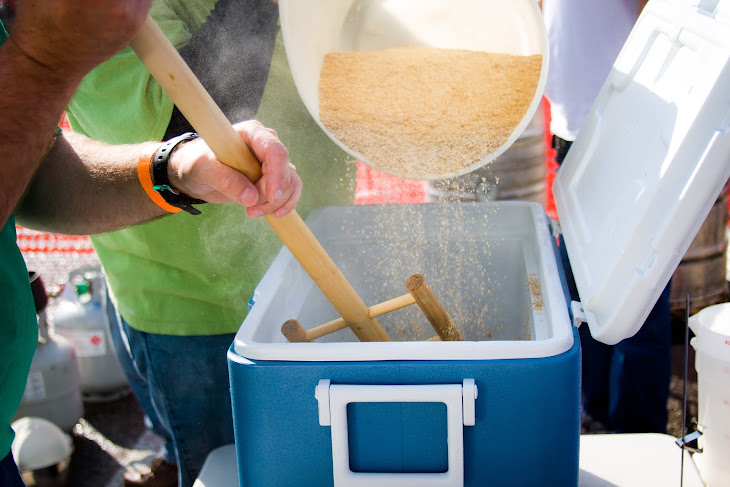Sunday, May 18, 2014
Hop Demand Increasing - Prices Are Too
GRAND RAPIDS, Mich. (NEWSCHANNEL 3) - The craft beer craze is sweeping the nation, and West Michigan has become a hotbed for microbreweries. But high demand is driving up prices for one of the main ingredients, and the consequence could be tough to swallow for craft beer lovers. Hops prices across the country are the highest they've been since a drought-damaged crop in 2008. Right now, brewers say they're paying roughly $7 to $14 per pound for Michigan-grown hops. But the growing value of hops is helping a fledgling industry grow stronger in Michigan. ...more
Thursday, May 15, 2014
Craft Beer Trends
Craft brewers are obsessed with hops, these flowers are a key ingredient that can make beer bitter, floral, earthy or citrusy, depending on the variety. Hoppy flavor is best experienced in a pale ale or an India Pale Ale. America's growing infatuation with craft beer has changed the farming business as well. The average price for all hops rose to $3.59 a pound in 2013, from $1.88 a pound in 2004. For the specialty hops often preferred by craft brewers, the price increases to around $7 to $10 a pound. The average beer uses about 0.2 pound of hops in every 31 gallons, but craft brewers can use as much as 1.25 pounds. Brewer demand seems to be centering around the aroma varieties of hops, which cost more because they don't yield as much. And farmers are adjusting their crops to meet that demand. In Washington state, the epicenter of U.S. hop farming, some 60 percent of hop acreage is devoted to aroma hops and 40 percent to the alpha hops that bring more bitterness to beers. Years ago, aroma hops were only planted 30 percent of the time.
Blame Sierra Nevada for some of the industry's hops fanaticism. The brewer's flagship pale ale was extremely hoppy when it came out in 1980, and beer drinkers loved how the bitterness blended with a grapefruit aroma and a spicy aftertaste. A decade later, breweries such as Stone and Lagunitas were "engaged in a hop arms race."
Craft brews now make up nearly 8 percent of all beer sold in the U.S. And with their popularity has come the inevitable drain on the nation's hops inventory. It's been a struggle for the hop industry to keep up with the new demand. That stands to hurt the smallest brewers the most, since they don't have the money to pursue forward contracts with farmers. That shortage could become especially painful for craft brewers next year when the multinational beer companies bring their deep pockets to the negotiating table. The beer industry giants have been snapping up small craft brewers with amazing speed, and they'll likely want more hops than ever.
You'd think farmers would be jumping into hops to meet the demand, but it's a bit more complicated than that. The initial investment for a hops farm can hit $250,000. And then there's the wait -- the plants need up to five years to hit full production. "It's a hell of a lot of work for just a little bit of money," said one hops trader. But the money side, at least, seems to be improving for hops farmers, and the craft beer boom shows no signs of fading.
Blame Sierra Nevada for some of the industry's hops fanaticism. The brewer's flagship pale ale was extremely hoppy when it came out in 1980, and beer drinkers loved how the bitterness blended with a grapefruit aroma and a spicy aftertaste. A decade later, breweries such as Stone and Lagunitas were "engaged in a hop arms race."
Craft brews now make up nearly 8 percent of all beer sold in the U.S. And with their popularity has come the inevitable drain on the nation's hops inventory. It's been a struggle for the hop industry to keep up with the new demand. That stands to hurt the smallest brewers the most, since they don't have the money to pursue forward contracts with farmers. That shortage could become especially painful for craft brewers next year when the multinational beer companies bring their deep pockets to the negotiating table. The beer industry giants have been snapping up small craft brewers with amazing speed, and they'll likely want more hops than ever.
You'd think farmers would be jumping into hops to meet the demand, but it's a bit more complicated than that. The initial investment for a hops farm can hit $250,000. And then there's the wait -- the plants need up to five years to hit full production. "It's a hell of a lot of work for just a little bit of money," said one hops trader. But the money side, at least, seems to be improving for hops farmers, and the craft beer boom shows no signs of fading.
Subscribe to:
Posts (Atom)


